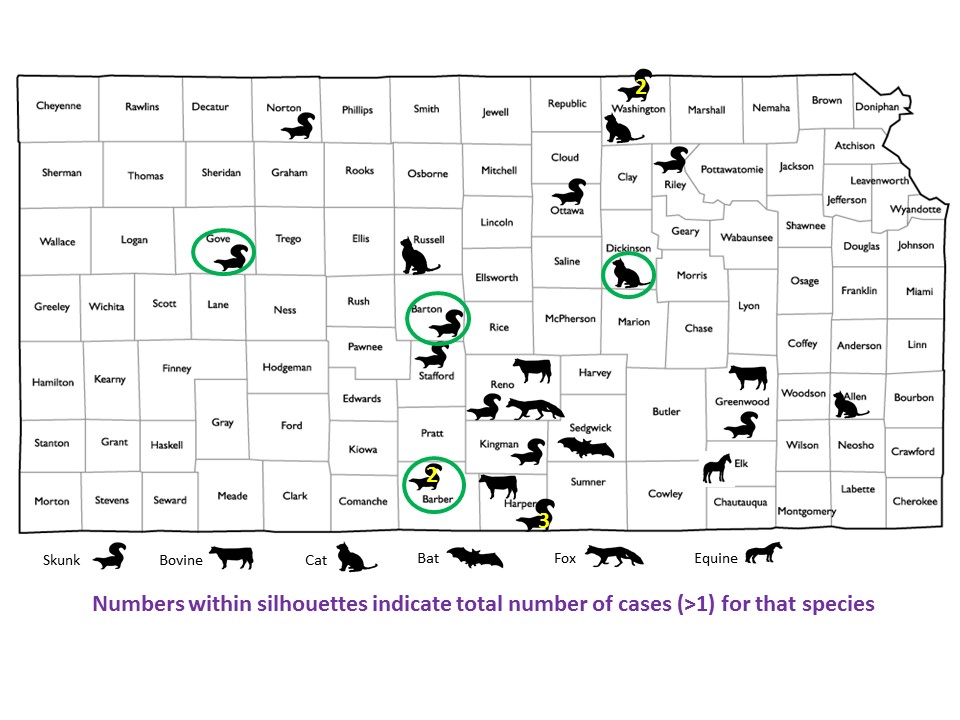
Rabies in Cattle
By: Ingrid C. Garrison, DVM, MPH, DACVPM, State Public Health Veterinarian, KDHE
Susan Moore, PhD, MS, MT(ASCP)SBB, Rabies Lab Director, KSVDL
What you need to know
- Rabies should be on the differential diagnosis list for: abnormal behavior, inability to swallow, lameness, and central nervous system abnormalities.
- Rabies virus is shed in saliva: wear personal protective equipment (gloves, goggles, mask) during physical exam, necropsy, and collecting specimens.
- Cattle are considered exposed to rabies if:
- A calf is nursing a rabid cow
- A cow is nursing a rabid calf
- A cow has been bitten by a rabid animal
- Rabies, in animals, is reportable to the Kansas Department of Health and Environment
at 1-877-427-7317. - The local health officer, with the local health department, has legal authority to determine quarantine location.
- Fresh, intact brain is needed for the rabies diagnostic test. Please call KSVDL Client Care @ 866-512-5650.
Clinical Disease
Cattle have been the primary domestic animal species with rabies in Kansas for the last 3 years. There were 10 cattle diagnosed with rabies in Kansas in 2015 and 3 cattle to date in 2016. The rabies virus is a lyssavirus and is highly neurotropic; the virus travels from the peripheral nerves to the spinal cord and into the brain. The incubation period is variable, usually 1-2 months, and depends upon the location of inoculation site. In Kansas rabies is typically transmitted through the bite of an infected skunk; the closer the bite is to the head of the cow the shorter the incubation period. The rabies virus causes encephalitis with rapid progression of the disease over the course of a few days to a week culminating in death. The initial signs are non-specific and can make diagnosing rabies challenging. Clinical signs are variable and can include anorexia, pruritis , ataxia, lameness, tenesmus, hypersalivation, and aggression. Rabid cattle may appear to be choking which prompts owners, and veterinarians, to insert a hand into the mouth in an attempt to remove a foreign body. Distinct vocalization, bellowing, that some veterinarians say is specific to rabies is a common sign. Rabies should be on the differential diagnosis list for cattle that exhibit abnormal behavior, inability to swallow or choke, neurological abnormalities, and lameness.
Prevent Exposure
The rabies virus is found in saliva and neural tissue (e.g. brain, spinal cord, nerves). Cattle can shed rabies virus in their saliva and can potentially infect other animals and humans. Veterinarians should wear personal protective equipment (PPE) when examining a suspect rabid animal, or when collecting/handling specimens, to prevent exposure to saliva. PPE should include disposable gloves and goggles or mask to prevent contact of mucous membranes or open cuts on skin with saliva or neural tissue. If you are exposed, immediately wash the wound or cut with soap and water. If saliva comes into contact with mucous membranes immediately flush with fresh clean water. Consult your healthcare provider for bite wound management to include; appropriate antimicrobial therapy, a tetanus immunization (if not current), and an evaluation for rabies post-exposure prophylaxis.
Veterinarians and others at frequent risk of rabies exposure, should be vaccinated and have their rabies titer checked every two years; a booster vaccine is recommended if the titer is below 0.1 IU/mL. If you have been previously immunized against rabies, and have been exposed, you will only need two doses of vaccine. For unvaccinated people after exposure, the complete post exposure treatment consists of administration of rabies immunoglobulin at the site of the bite and a series of rabies vaccinations. The Kansas Department of Health and Environment can provide recommendations for post-exposure prophylaxis to veterinarians and healthcare providers.
Public Health
Rabies in animals is reportable, by state statue, to the Kansas Department of Health and Environment. The brain tissues of rabies suspect animals are examined for the presence of rabies infection at the KSVDL Rabies Laboratory. The laboratory notifies KDHE of all rabies positive animals. The local health department will conduct an investigation to identify people, and animals, that were potentially exposed to the rabid cow and provide recommendations for rabies post-exposure prophylaxis for people. The local health department also has the authority to quarantine unvaccinated animals that were exposed to the rabid animal. If a rabid cow is nursing a calf the calf is considered exposed to rabies. If a nursing calf is rabid, the cow is considered exposed to rabies. The exposed animals (if not vaccinated against rabies) can be immediately euthanized or quarantined for 6 months. Cattle exposed to rabies cannot be processed at a USDA facility; however, they may be custom slaughtered. Rabies vaccination is recommended for valuable stock, and show cattle, or for livestock that has frequent contact with the public.
If you suspect rabies in any animal, contact your local health department or KDHE at 1-877-427-7317 or EpiHotline@kdheks.gov. More information about rabies, including management of other animal species and post-exposure prophylaxis, can be found at; http://www.kdheks.gov/epi/human_animal_health.htm
Diagnostic Test
Fresh, intact brain is needed for rabies testing. Contact the Rabies Laboratory for instructions to submit a rabies suspect specimen or to submit a serum sample for rabies titer check at 1-866-512-5650 or clientcare@vet.k-state.edu; submission information and information on rabies occurrence in Kansas and Nebraska can be found at http://www.ksvdl.org/rabies-laboratory/diagnostic-test/index.html . A video on bovine rabies sample collection is available on the KSVDL YouTube Channel; https://www.youtube.com/watch?v=01gXa8KkuPA
Extraordinary KSU College of Veterinary Medicine Student Efforts
Return to Index